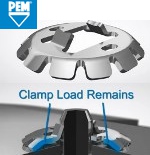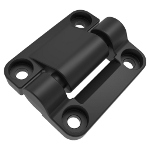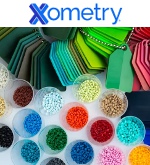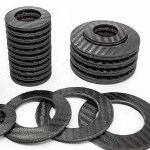 |
| October 10, 2023 | Volume 19 Issue 38 |
Mechanical News & Products
Designfax weekly eMagazine
Archives
Partners
Manufacturing Center
Product Spotlight
Modern Applications News
Metalworking Ideas For
Today's Job Shops
Tooling and Production
Strategies for large
metalworking plants
New 'breathable' rupture disk tech provides overpressure and vacuum relief
 To increase equipment safety and reliability, a new rupture disk technology activates at a set burst pressure, but it can also "breathe" to relieve minor pressure fluctuations. The patent-pending, dual-function device from BS&B Safety Systems is ideal for use on low-pressure vessels that are susceptible to ambient temperature changes.
To increase equipment safety and reliability, a new rupture disk technology activates at a set burst pressure, but it can also "breathe" to relieve minor pressure fluctuations. The patent-pending, dual-function device from BS&B Safety Systems is ideal for use on low-pressure vessels that are susceptible to ambient temperature changes.
Read the full article.
Engineer's Toolbox: 9 considerations for specifying a slewing ring bearing
 In applications that require a bearing to support a structure while it rotates (e.g., cranes, radar, tank turrets), premature bearing failure can put people and equipment at risk. While slewing ring bearings have proven themselves countless times in such applications, designers must consider many factors when specifying them. According to engineers at Kaydon, the bearing's support structure, mounting (including bolt strength, tensioning, and hole patterns), installation, and even storage are all factors in a bearing's success or failure.
In applications that require a bearing to support a structure while it rotates (e.g., cranes, radar, tank turrets), premature bearing failure can put people and equipment at risk. While slewing ring bearings have proven themselves countless times in such applications, designers must consider many factors when specifying them. According to engineers at Kaydon, the bearing's support structure, mounting (including bolt strength, tensioning, and hole patterns), installation, and even storage are all factors in a bearing's success or failure.
Read the full article.
ClampDisk micro fastener is new alternative for automotive and consumer electronics
 Designed as a unique alternative in assemblies for the automotive and consumer electronics markets, the ClampDisk Press-on Fastener is a new offering from PennEngineering that delivers a fast, simple way to achieve sheet-to-sheet clamped fastening while replacing the use of standard screws, nuts, and adhesives. The most common challenges that can be eliminated or reduced by using ClampDisk include over installation, cross threading, stripped screw heads, broken screws, and damaged product. This fastener can be removed easily with a sharp-edged tool.
Designed as a unique alternative in assemblies for the automotive and consumer electronics markets, the ClampDisk Press-on Fastener is a new offering from PennEngineering that delivers a fast, simple way to achieve sheet-to-sheet clamped fastening while replacing the use of standard screws, nuts, and adhesives. The most common challenges that can be eliminated or reduced by using ClampDisk include over installation, cross threading, stripped screw heads, broken screws, and damaged product. This fastener can be removed easily with a sharp-edged tool.
Learn more and see how ClampDisk works.
New nylon constant torque hinge
 Southco has expanded its line of E6 Constant Torque Hinges with a compact, nylon version designed for small applications. The newest addition to the company's E6 50 Constant Torque Position Control Hinge series measures 45 mm with a torque range of 4 to 16 in./lb and is 65% lighter compared to the standard E6 50 Hinge. It provides constant resistance throughout the entire range of motion, enabling users to easily position doors, display screens, and other mounted components and hold them securely at any desired angle.
Southco has expanded its line of E6 Constant Torque Hinges with a compact, nylon version designed for small applications. The newest addition to the company's E6 50 Constant Torque Position Control Hinge series measures 45 mm with a torque range of 4 to 16 in./lb and is 65% lighter compared to the standard E6 50 Hinge. It provides constant resistance throughout the entire range of motion, enabling users to easily position doors, display screens, and other mounted components and hold them securely at any desired angle.
Learn more.
What injection molding material do I use?
 How do you decide what type of plastic to use for your next injection molding project? Xometry can help you narrow your choices. Discover the different strengths and applications for materials that could be ideal for your application by learning about the most common plastic injection molding materials in detail.
How do you decide what type of plastic to use for your next injection molding project? Xometry can help you narrow your choices. Discover the different strengths and applications for materials that could be ideal for your application by learning about the most common plastic injection molding materials in detail.
Read this detailed Xometry article.
What are carbon composite bellows springs?
 The Carbon Composite Bellows Spring (CCBS) from MW Components is a system of carbon fiber elements that combine to work as a high-performance, lightweight, and design-flexible compression spring meant to replace coil springs or metallic Belleville disc springs. A functional spring is made from several individual elements paired and joined to make a stack. The stack spring rate is determined by the number of elements, the base rate of each element, and their series or parallel orientation in the stack. Applications include motorsports, aerospace, and high-performance activities.
The Carbon Composite Bellows Spring (CCBS) from MW Components is a system of carbon fiber elements that combine to work as a high-performance, lightweight, and design-flexible compression spring meant to replace coil springs or metallic Belleville disc springs. A functional spring is made from several individual elements paired and joined to make a stack. The stack spring rate is determined by the number of elements, the base rate of each element, and their series or parallel orientation in the stack. Applications include motorsports, aerospace, and high-performance activities.
Learn more.
Conductive Brush Ring overcomes current leakage in EV powertrains
 SKF's new Conductive Brush Ring paves the way to greater reliability and longer life in high-performance electric vehicle powertrain systems. Using pure carbon fiber bristles, it provides a reliable electrical connection between an EV eAxle rotor shaft and its housing. When used in combination with SKF Hybrid ceramic ball bearings, it helps to alleviate parasitic current effects that can lead to premature failure in bearings and other components. Available in different configurations for wet (oil-lubricated) motor designs -- and soon for dry (sealed) applications.
SKF's new Conductive Brush Ring paves the way to greater reliability and longer life in high-performance electric vehicle powertrain systems. Using pure carbon fiber bristles, it provides a reliable electrical connection between an EV eAxle rotor shaft and its housing. When used in combination with SKF Hybrid ceramic ball bearings, it helps to alleviate parasitic current effects that can lead to premature failure in bearings and other components. Available in different configurations for wet (oil-lubricated) motor designs -- and soon for dry (sealed) applications.
Learn more.
hyperMILL 2024 CAD/CAM software suite
 OPEN MIND Technologies has introduced its latest hyperMILL 2024 CAD/CAM software suite, which includes a range of powerful enhancements to its core toolpath capabilities, as well as new functionality for increased NC programming efficiency in applications ranging from 2.5D machining to 5-axis milling. New and enhanced capabilities include: Optimized Deep Hole Drilling, a new algorithm for 3- and 5-axis Rest Machining, an enhanced path layout for the 3D Plane Machining cycle, better error detection, and much more.
OPEN MIND Technologies has introduced its latest hyperMILL 2024 CAD/CAM software suite, which includes a range of powerful enhancements to its core toolpath capabilities, as well as new functionality for increased NC programming efficiency in applications ranging from 2.5D machining to 5-axis milling. New and enhanced capabilities include: Optimized Deep Hole Drilling, a new algorithm for 3- and 5-axis Rest Machining, an enhanced path layout for the 3D Plane Machining cycle, better error detection, and much more.
Learn more.
One-part epoxy changes from red to clear under UV
 Master Bond UV15RCL is a low-viscosity, cationic-type UV-curing system with a special color-changing feature. The red material changes to clear once exposed to UV light, indicating that there is UV light access across the adhesive material. Although this change in color from red to clear does not indicate a full cure, it does confirm that the UV light has reached the polymer. This epoxy is an excellent electrical insulator. UV15RCL adheres well to metals, glass, ceramics, and many plastics, including acrylics and polycarbonates.
Master Bond UV15RCL is a low-viscosity, cationic-type UV-curing system with a special color-changing feature. The red material changes to clear once exposed to UV light, indicating that there is UV light access across the adhesive material. Although this change in color from red to clear does not indicate a full cure, it does confirm that the UV light has reached the polymer. This epoxy is an excellent electrical insulator. UV15RCL adheres well to metals, glass, ceramics, and many plastics, including acrylics and polycarbonates.
Learn more.
SPIROL Press-N-Lok™ Pin for plastic housings
 The Press-N-Lok™ Pin was designed to permanently retain two plastic components to each other. As the pin is inserted, the plastic backfills into the area around the two opposing barbs, resulting in maximum retention. Assembly time is quicker, and it requires lower assembly equipment costs compared to screws and adhesives -- just Press-N-Lok™!
The Press-N-Lok™ Pin was designed to permanently retain two plastic components to each other. As the pin is inserted, the plastic backfills into the area around the two opposing barbs, resulting in maximum retention. Assembly time is quicker, and it requires lower assembly equipment costs compared to screws and adhesives -- just Press-N-Lok™!
Learn more about the new Press-N-Lok™ Pin.
Why hybrid bearings are becoming the new industry standard
 A combination of steel outer and inner rings with ceramic balls or rollers is giving hybrid bearings unique properties, making them suitable for use in a wide range of modern applications. SKF hybrid bearings make use of silicon nitride (twice as hard as bearing steel) rolling elements and are available as ball bearings, cylindrical roller bearings, and in custom designs. From electric erosion prevention to friction reduction and extended maintenance intervals, learn all about next-gen hybrid bearings.
A combination of steel outer and inner rings with ceramic balls or rollers is giving hybrid bearings unique properties, making them suitable for use in a wide range of modern applications. SKF hybrid bearings make use of silicon nitride (twice as hard as bearing steel) rolling elements and are available as ball bearings, cylindrical roller bearings, and in custom designs. From electric erosion prevention to friction reduction and extended maintenance intervals, learn all about next-gen hybrid bearings.
Read the SKF technical article.
3M and Ansys train engineers on simulating adhesives
 Ansys and 3M have created an advanced simulation training program enabling engineers to enhance the design and sustainability of their products when using tapes and adhesives as part of the design. Simulation enables engineers to validate engineering decisions when analyzing advanced polymeric materials -- especially when bonding components made of different materials. Understand the behavior of adhesives under real-world conditions for accurate modeling and design.
Ansys and 3M have created an advanced simulation training program enabling engineers to enhance the design and sustainability of their products when using tapes and adhesives as part of the design. Simulation enables engineers to validate engineering decisions when analyzing advanced polymeric materials -- especially when bonding components made of different materials. Understand the behavior of adhesives under real-world conditions for accurate modeling and design.
Read this informative Ansys blog.
New FATH T-slotted rail components in black from AutomationDirect
 Automation-Direct has added a wide assortment of black-colored FATH T-slotted hardware components to match their SureFrame black anodized T-slotted rails, including: cube connectors (2D and 3D) and angle connectors, joining plates of many types, brackets, and pivot joints. Also included are foot consoles, linear bearings in silver and black, cam lever brakes, and L-handle brakes. FATH T-slotted hardware components are easy to install, allow for numerous T-slotted structure configurations, and have a 1-year warranty against defects.
Automation-Direct has added a wide assortment of black-colored FATH T-slotted hardware components to match their SureFrame black anodized T-slotted rails, including: cube connectors (2D and 3D) and angle connectors, joining plates of many types, brackets, and pivot joints. Also included are foot consoles, linear bearings in silver and black, cam lever brakes, and L-handle brakes. FATH T-slotted hardware components are easy to install, allow for numerous T-slotted structure configurations, and have a 1-year warranty against defects.
Learn more.
Weird stuff: Moon dust simulant for 3D printing
 Crafted from a lunar regolith simulant, Basalt Moon Dust Filamet™ (not a typo) available from The Virtual Foundry closely mirrors the makeup of lunar regolith found in mare regions of the Moon. It enables users with standard fused filament fabrication (FFF) 3D printers to print with unparalleled realism. Try out your ideas before you go for that big space contract, or help your kid get an A on that special science project.
Crafted from a lunar regolith simulant, Basalt Moon Dust Filamet™ (not a typo) available from The Virtual Foundry closely mirrors the makeup of lunar regolith found in mare regions of the Moon. It enables users with standard fused filament fabrication (FFF) 3D printers to print with unparalleled realism. Try out your ideas before you go for that big space contract, or help your kid get an A on that special science project.
Learn more.
Break the mold with custom injection molding by Rogan
 With 90 years of industry experience, Rogan Corporation possesses the expertise to deliver custom injection molding solutions that set businesses apart. As a low-cost, high-volume solution, injection molding is the most widely used plastics manufacturing process. Rogan processes include single-shot, two-shot, overmolding, and assembly. Elevate your parts with secondary operations: drilling and tapping, hot stamping, special finishes, punch press, gluing, painting, and more.
With 90 years of industry experience, Rogan Corporation possesses the expertise to deliver custom injection molding solutions that set businesses apart. As a low-cost, high-volume solution, injection molding is the most widely used plastics manufacturing process. Rogan processes include single-shot, two-shot, overmolding, and assembly. Elevate your parts with secondary operations: drilling and tapping, hot stamping, special finishes, punch press, gluing, painting, and more.
Learn more.
What's a plastron? Protective surface could keep metals dry under water for months
A species of spider lives its entire life underwater, despite having lungs that can only breathe atmospheric oxygen. How does it do it? This spider, known as the Argyroneta aquatica, has millions of rough, water-repellent hairs that trap air around its body, creating an oxygen reservoir and acting as a barrier between the spider's lungs and the water.
This thin layer of air is called a plastron, and material scientists have been trying to harness its protective effects for decades. Doing so could lead to underwater superhydrophobic surfaces able to prevent corrosion, bacterial growth, the adhesion of marine organisms, chemical fouling, and other deleterious effects of liquid on surfaces. But plastrons have proved highly unstable under water, keeping surfaces dry for only a matter of hours in the lab.
VIDEO: A superhydrophobic surface with a stable plastron repels water droplets. [Credit: Alexander B. Tesler/Friedrich-Alexander-Universität Erlangen-Nürnberg]
Now, a team of researchers led by the Harvard John A. Paulson School of Engineering and Applied Sciences (SEAS), the Wyss Institute for Biologically Inspired Engineering at Harvard, the Friedrich-Alexander-Universität Erlangen-Nürnberg in Germany, and Aalto University in Finland have developed a superhydrophobic surface with a stable plastron that can last for months under water. The team's general strategy to create long-lasting underwater superhydrophobic surfaces, which repel blood and drastically reduce or prevent the adhesion of bacterial and marine organisms such as barnacles and mussels, opens a range of applications in biomedicine and industry.
"Research in bioinspired materials is an extremely exciting area that continues to bring into the realm of man-made materials elegant solutions evolved in nature, which allow us to introduce new materials with properties never seen before," said Joanna Aizenberg, Amy Smith Berylson Professor of Materials Science and Professor of Chemistry & Chemical Biology at SEAS and co-author of the paper. "This research exemplifies how uncovering these principles can lead to developing surfaces that maintain superhydrophobicity under water." Aizenberg is also an associate faculty member of the Wyss Institute.
The research is published in Nature Materials.
Researchers have known for 20 years that a stable, underwater plastron was theoretically possible but, until now, haven't been able to show it experimentally.
One of the biggest issues with plastrons is that they need rough surfaces to form, like the hair of Argyroneta aquatica. However, this roughness makes the surface mechanically unstable and susceptible to any small perturbation in temperature, pressure, or tiny defect.
Current techniques to assess artificially made superhydrophobic surfaces only take into account two parameters, which don't give enough information about the stability of the air plastron underwater. Aizenberg, Jaakko V. I. Timonen, and Robin H. A. Ras from Aalto University, and Alexander B. Tesler and Wolfgang H. Goldmann from FAU and their teams identified a larger group of parameters, including information on surface roughness, the hydrophobicity of the surface molecules, plastron coverage, contact angles, and more, which, when combined with thermodynamic theory, allowed them to figure out if the air plastron would be stable.
With this new method and a simple manufacturing technique, the team designed a so-called aerophilic surface from a commonly used and inexpensive titanium alloy with a long-lasting plastron that kept the surface dry thousands of hours longer than previous experiments and even longer than the plastrons of living species.
"We used a characterization method that had been suggested by theorists 20 years ago to prove that our surface is stable, which means that not only have we made a novel type of extremely repellent, extremely durable superhydrophobic surface, but we can also have a pathway of doing it again with a different material," said Tesler, a former postdoctoral fellow at SEAS and the Wyss Institute, and lead author of the paper.
To prove the stability of the plastron, the researchers put the surface through the ringer -- bending it, twisting it, blasting it with hot and cold water, and abrading it with sand and steel to block the surface remaining aerophilic. It survived 208 days submerged in water and hundreds of dunks in a petri dish of blood. It severely reduced the growth of E.coli and barnacles on its surface and stopped the adhesion of mussels altogether.
VIDEO: A aerophilic surface made from a commonly used and inexpensive titanium alloy with a long-lasting plastron keeps dry during hundreds of dunks in a petri dish of blood. [Credit: Alexander B. Tesler/Friedrich-Alexander-Universität Erlangen-Nürnberg]
"The stability, simplicity, and scalability of this system make it valuable for real-world applications," said Stefan Kolle, a graduate student at SEAS and co-author of the paper. "With the characterization approach shown here, we demonstrate a simple toolkit that allows you to optimize your superhydrophobic surface to reach stability, which dramatically changes your application space."
That application space includes biomedical applications, where it could be used to reduce infection after surgery or as biodegradable implants such as stents, according to Goldmann, senior author of the paper, and former Harvard fellow. It also includes underwater applications, where it could prevent corrosion in pipelines and sensors. In the future, it could even be used in combination with the super-slick coating known as SLIPS, the Slippery Liquid-Infused Porous Surfaces, developed by Aizenberg and her team more than a decade ago, to protect surfaces even further from contamination.
Source: Harvard John A. Paulson School of Engineering and Applied Sciences
Published October 2023
Rate this article
View our terms of use and privacy policy

